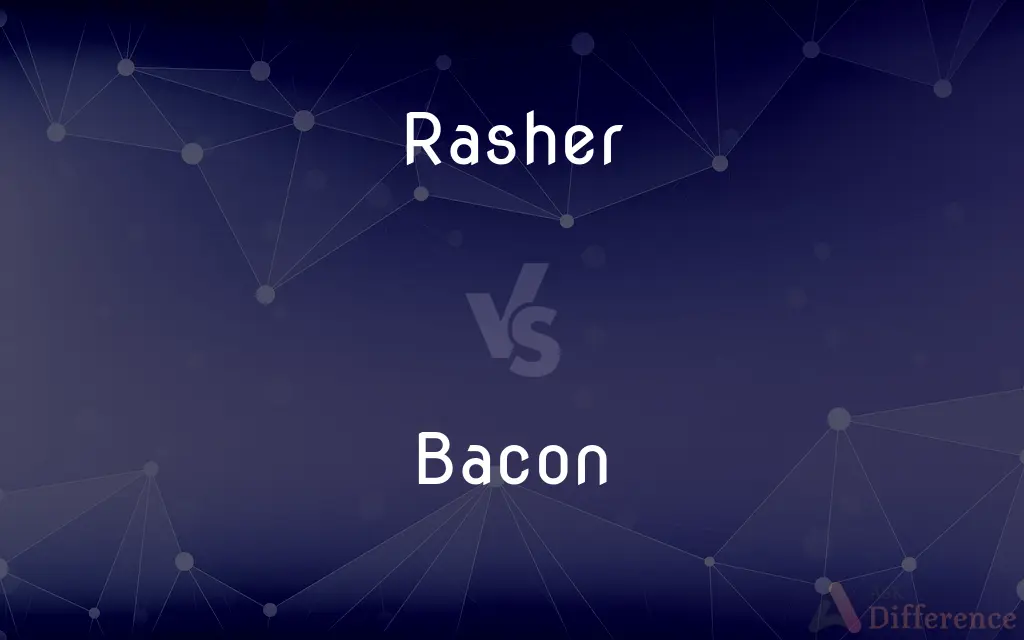Rasher vs. Bacon — What's the Difference?
By Fiza Rafique & Maham Liaqat — Updated on March 18, 2024
A "rasher" refers to a thin slice of bacon or ham, while "bacon" is a cured meat product typically made from pork belly or back cuts.

Difference Between Rasher and Bacon
Table of Contents
ADVERTISEMENT
Key Differences
A rasher is specifically a slice of bacon or ham, often served as part of a traditional breakfast. It's a term commonly used in the UK and Ireland to denote a single serving slice, emphasizing the form in which the bacon is served. Bacon, on the other hand, refers more broadly to the cured meat product made from various cuts of pork, primarily the belly or back. It's known for its rich, savory flavor and is a staple in various cuisines worldwide, celebrated for its versatility in cooking.
While a rasher is defined by its thin slice, bacon is identified by the curing process it undergoes, which involves salt and various flavorings. This process not only imparts a distinct taste but also preserves the bacon, allowing it to be stored for longer periods. Rashers, as slices, are a direct result of how bacon is prepared and presented for consumption, making them a subset within the broader category of bacon products.
In culinary contexts, the term "rasher" often signals a specific serving size, typically one or two thin slices, and is closely associated with breakfast dishes. Bacon, due to its broader definition, is used in a wide array of recipes, from breakfast items like bacon and eggs to complex culinary creations where it adds depth and richness. This demonstrates the versatile nature of bacon beyond its sliced form as a rasher.
The distinction also extends to regional preferences and terminologies. In the UK and Ireland, "rasher" is a common term, reflecting the traditional way bacon is consumed there. In contrast, in the United States and other regions, the term "bacon" alone is frequently used, with less emphasis on the individual slice and more on the product as a whole. This highlights how cultural and regional differences influence the terminology and consumption patterns related to bacon.
In summary, while a rasher specifically refers to a thin slice of bacon or ham, ideal for serving, bacon itself is a broader category encompassing the cured pork product from which rashers are cut. The distinction between the two terms sheds light on the nuances of food terminology and the cultural influences that shape our understanding and consumption of popular foods like bacon.
ADVERTISEMENT
Comparison Chart
Definition
A thin slice of bacon or ham.
Cured pork product, typically from belly or back cuts.
Serving
Typically one or two slices.
Served in slices, chunks, or bits.
Preparation
Sliced from cured bacon or ham.
Cured with salt and possibly smoked or flavored.
Usage
Common in breakfast dishes.
Versatile, used in various dishes across meals.
Regional Term
Common in UK and Ireland.
Widely used term, especially in the US.
Compare with Definitions
Rasher
A thin slice of bacon, often enjoyed as part of breakfast.
I usually have a rasher or two of bacon with my eggs in the morning.
Bacon
Cured meat from the pork belly or back, known for its rich flavor.
The bacon was smoked to enhance its savory taste.
Rasher
Often fried or grilled until crispy.
The rashers were cooked to perfection, crispy on the edges but still tender.
Bacon
Often served in slices but can be diced or in lardons for cooking.
The recipe called for diced bacon to be added to the soup.
Rasher
A serving size term predominantly used in the UK and Ireland.
For a full English breakfast, how many rashers would you like?
Bacon
A staple in various cuisines, used in many recipes.
Bacon adds a delicious depth of flavor to this pasta dish.
Rasher
Can also refer to a slice of ham.
He opted for a rasher of ham on his sandwich instead of cheese.
Bacon
Can be smoked or unsmoked, influencing its flavor profile.
She preferred unsmoked bacon for a milder taste.
Rasher
A term denoting a specific portion of bacon.
Each sandwich comes with two rashers of bacon for added flavor.
Bacon
A key ingredient in many breakfast dishes, sandwiches, and salads.
The classic BLT sandwich features bacon as a central component.
Rasher
A thin slice of bacon
Two rashers of lean bacon
He cut into one of the rashers on his plate
Bacon
Bacon is a type of salt-cured pork made from various cuts, typically from the pork belly or from the less fatty back cuts. It is eaten on its own, as a side dish (particularly in breakfasts), or used as a minor ingredient to flavour dishes (e.g., the club sandwich).
Rasher
A thin slice of fried or broiled bacon.
Bacon
The salted and smoked meat from the back and sides of a pig.
Rasher
A dish or an order of thin slices of fried or broiled bacon.
Bacon
Cured meat from the sides, belly, or back of a pig.
Rasher
A strip of bacon; a piece of bacon.
Bacon
Thin slices of the above in long strips.
Rasher
A strip, a piece (of something, such as ham, bacon, etc).
Bacon
The police or spies.
Run! It's the bacon!
Rasher
(transitive) To cut into rashers.
Bacon
Road rash.
Rasher
A thin slice of bacon.
Bacon
A saucisse.
Rasher
A California rockfish (Sebastichthys miniatus).
Bacon
The back and sides of a pig salted and smoked; formerly, the flesh of a pig salted or fresh.
Rasher
A commercially important fish of the Pacific coast of North America
Bacon
Back and sides of a hog salted and dried or smoked; usually sliced thin and fried
Bacon
English scientist and Franciscan monk who stressed the importance of experimentation; first showed that air is required for combustion and first used lenses to correct vision (1220-1292)
Bacon
English statesman and philosopher; precursor of British empiricism; advocated inductive reasoning (1561-1626)
Common Curiosities
What is a bacon rasher?
A bacon rasher is a thin slice of bacon, typically served as part of a traditional breakfast.
What's the difference between smoked and unsmoked bacon?
Smoked bacon has been treated with smoke from wood chips, adding a distinct smoky flavor, while unsmoked bacon retains the natural flavor of the cured pork.
Is bacon consumption common worldwide?
Bacon is popular in many parts of the world, especially in Western cuisines, though its preparation and consumption may vary due to cultural and dietary preferences.
Are there alternatives to pork bacon?
Yes, there are alternatives like turkey bacon or vegetarian bacon substitutes that mimic the texture and flavor of traditional pork bacon.
How do you store bacon to maintain its freshness?
Bacon should be stored in the refrigerator and kept in its original packaging until ready to use, or it can be frozen for longer storage.
How long should you cook a bacon rasher?
Cooking times vary depending on the thickness and personal preference, but rashers are typically cooked until crispy, which can take a few minutes per side.
How is bacon typically cured?
Bacon is typically cured using salt and may also be smoked or flavored with additional ingredients like maple or spices.
What dishes can be enhanced with bacon?
Bacon can enhance a wide range of dishes, from breakfast staples like pancakes and eggs to complex entrees and salads.
Can you use bacon rashers in recipes other than breakfast?
Yes, bacon rashers can be used in a variety of recipes, from sandwiches and salads to gourmet dishes, adding flavor and texture.
Can bacon be part of a healthy diet?
Bacon can be enjoyed in moderation as part of a balanced diet, though it's high in fat and sodium, so it's advisable to consume it sparingly.
Is there a difference in bacon cuts around the world?
Yes, the cut of bacon can vary globally, with American bacon typically coming from the pork belly, while in the UK, it often comes from the back.
What's the best way to achieve crispy bacon rashers?
For crispy bacon rashers, cook them in a hot pan over medium-high heat, or bake in the oven on a rack to allow the fat to render out.
Can bacon be eaten raw?
It's not recommended to eat bacon raw due to the risk of foodborne illnesses; it should be thoroughly cooked before consumption.
Share Your Discovery

Previous Comparison
Slice vs. Cut
Next Comparison
Repeat vs. RecurringAuthor Spotlight
Written by
Fiza RafiqueFiza Rafique is a skilled content writer at AskDifference.com, where she meticulously refines and enhances written pieces. Drawing from her vast editorial expertise, Fiza ensures clarity, accuracy, and precision in every article. Passionate about language, she continually seeks to elevate the quality of content for readers worldwide.
Co-written by
Maham Liaqat















































